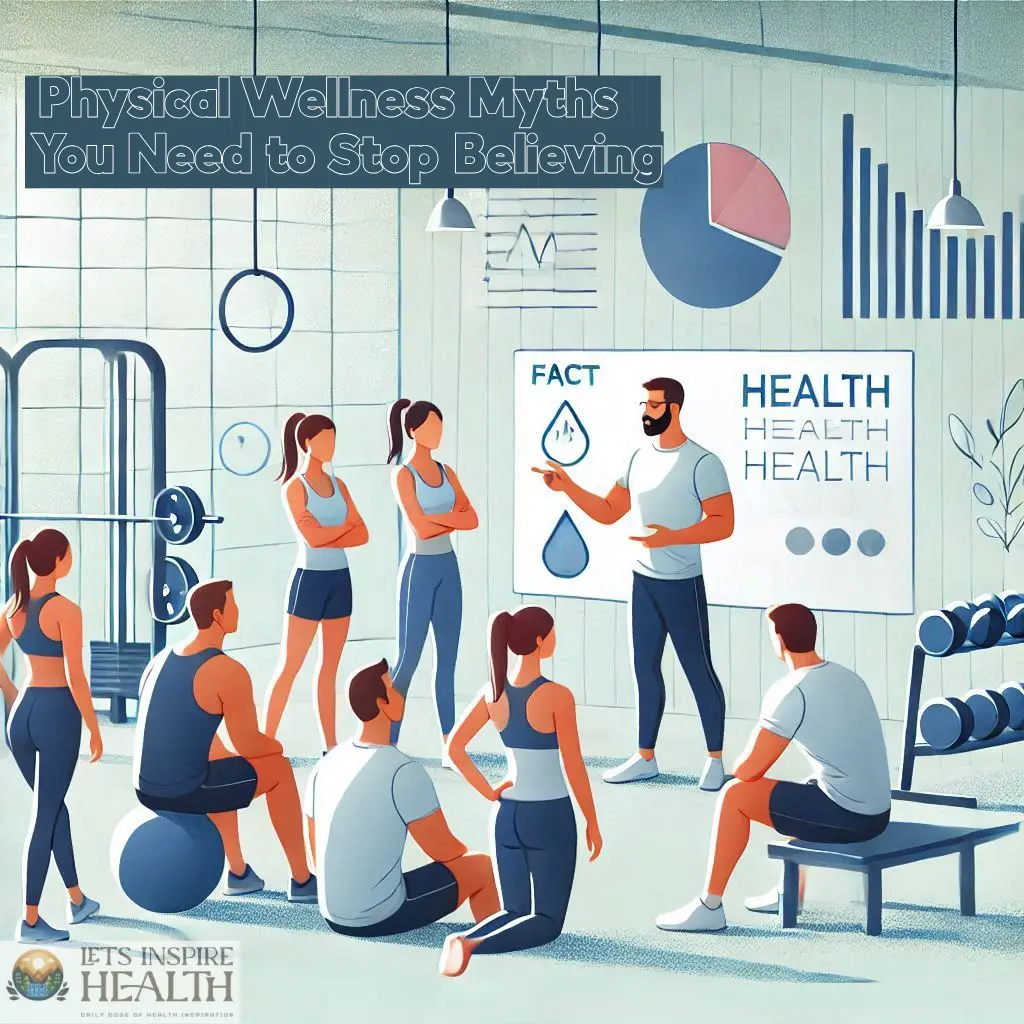Busting Physical Wellness Myths for Better Health
Myth 1: “No Pain, No Gain” Is the Rule for Fitness
Hook:
How many times have you heard the phrase, “No pain, no gain”? While it sounds inspiring, is it actually true?
The Reality:
Pain is not a reliable indicator of progress. Discomfort from muscle engagement during exercise is normal, but sharp or prolonged pain signals potential injury. Overexertion can harm your body, leading to burnout or even chronic conditions.
Health Effects:
- Pros of proper training: Builds strength, enhances flexibility, and boosts cardiovascular health.
- Cons of overexertion: Risk of injuries, joint damage, and mental exhaustion.
Tip:
Listen to your body. A well-rounded fitness routine includes rest and recovery days, not just high-intensity workouts.
Myth 2: “You Should Stretch Before Every Workout”
Hook:
Stretching before exercise seems like a golden rule, but could it actually hinder your performance?
The Reality:
Static stretching before workouts can reduce strength and stability. Dynamic warm-ups, such as leg swings or light jogging, are more effective in preparing your body. Save static stretches for post-exercise cooldowns.
Health Effects:
- Dynamic warm-ups: Improve performance and reduce the risk of injury.
- Static stretching pre-workout: May lead to reduced power and agility.
Checklist for Pre-Workout Prep:
- Start with light cardio for 5-10 minutes.
- Perform dynamic stretches focusing on the muscles you’ll engage.
- Stay hydrated to maintain endurance.
Myth 3: “Carbs Are the Enemy of Physical Wellness”
Hook:
Carbohydrates often get vilified in modern diets, but are they truly the bad guys?
The Reality:
Carbs are your body’s primary energy source. Cutting them completely can cause fatigue, irritability, and a decline in performance. Instead, focus on consuming complex carbs like whole grains, legumes, and vegetables.
Health Effects:
- Including carbs: Provides sustained energy, improves brain function, and supports recovery.
- Excluding carbs: Causes energy crashes, nutritional deficiencies, and weakened immunity.
Comparison Table: Simple vs. Complex Carbs
| Simple Carbs | Complex Carbs |
| Quick energy, short-lived | Long-lasting energy |
| Found in sugary drinks | Found in whole grains |
| May cause sugar spikes | Stabilizes blood sugar |
Myth 4: “Sweating Means You’re Burning Fat”
Hook:
Does sweating buckets during a workout mean you’re burning fat? Not exactly.
The Reality:
Sweat is your body’s cooling mechanism, not a direct indicator of fat loss. Fat burn depends on energy expenditure and calorie balance, not how drenched your clothes are after exercising.
Health Effects:
- Sweating: Prevents overheating but varies based on genetics and environment.
- Fat burning: Achieved through consistent workouts and balanced nutrition.
Myth 5: “You Can Spot-Reduce Fat in Certain Areas”
Hook:
Dreaming of a flatter stomach or thinner thighs by targeting specific exercises? Unfortunately, it’s a myth.
The Reality:
Fat loss is systemic, not localized. Engaging in overall fitness activities like cardio and strength training helps reduce fat uniformly. Spot-training only strengthens muscles in specific areas without necessarily burning fat there.
Tip:
Combine a balanced diet with a mix of aerobic and anaerobic exercises for optimal results.
Myth 6: “Detox Diets Are Essential for Wellness”
Hook:
Detox diets promise quick health fixes, but are they worth the hype?
The Reality:
Your liver and kidneys are your body’s natural detoxifiers. Extreme detox plans can deprive you of essential nutrients and energy. Instead, focus on a balanced diet with plenty of water and fiber.
Health Effects:
- Balanced diet: Improves digestion and supports natural detoxification.
- Detox diets: Can cause nutrient deficiencies and fatigue.
Pro Tip:
A glass of warm lemon water is refreshing but doesn’t “detox” your system. Stay informed about what your body truly needs.
Myth 7: “You Must Exercise Daily to Stay Healthy”
Hook:
Rest days are not the enemy—they’re a crucial part of your fitness journey.
The Reality:
Overtraining can lead to fatigue, injuries, and a decrease in performance. Alternating intense workout days with active recovery (like yoga or walking) promotes long-term success.
Health Effects:
- Rest days: Allow muscle repair and mental recharge.
- Overtraining: Weakens immunity and elevates stress levels.
Checklist for a Balanced Routine:
- Strength training: 3-4 days a week.
- Cardio: 2-3 days a week.
- Rest or active recovery: 1-2 days a week.
Conclusion: Stop Believing the Myths, Start Living the Facts
The journey to physical wellness is paved with knowledge and mindful practices. By debunking these myths, you can focus on what truly matters—your health and well-being. Avoid shortcuts and misinformation, and always consult a healthcare professional for personalized advice.
Disclaimer: This blog is for informational purposes only and should not be considered a substitute for professional medical advice. Always consult your healthcare provider for any health-related decisions.







